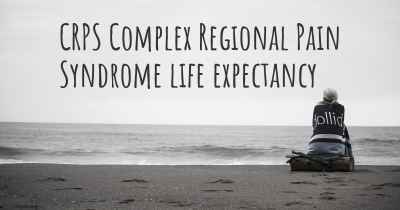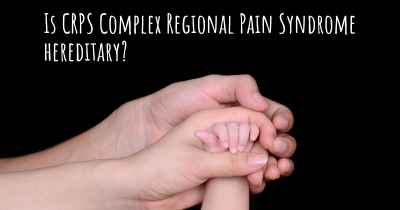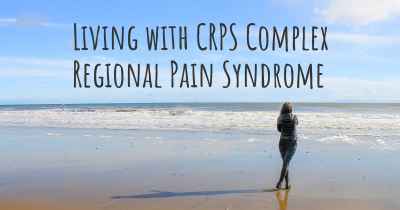10
Which are the causes of CRPS Complex Regional Pain Syndrome?
See some of the causes of CRPS Complex Regional Pain Syndrome according to people who have experience in CRPS Complex Regional Pain Syndrome

Usually some sort of tramua is the cause of CRPS. Or sometimes it can even just develop from nothing.
-falls (sprains/ broken bones)
-cuts
-falls (sprains/ broken bones)
-cuts
Posted Apr 20, 2017 by Chloe 1000
Well causes of CRPS are complicated. I personally believe anybody can get CRPS through an injury to a nerve or inflammation to a tendon/ligament that subsequently affects a nerve. However, I do believe some people are born with this disease, some are born more predisposed but maybe won't have manifestations and some develop the disease overtime. There isn't enough knowledge out there to fully understand the complexities. I've been sick my whole life and have had other diseases like osteochondritis dissecans. But I've also contracted things like meningitis and MERSA. So was I born with this disease? I don't think there is a clear answer as to why or how we get anything.
Posted May 9, 2017 by Jon 1100
The causes of CRPS are thought to be accidents, surgeries, broken bones, etc.
Posted Aug 17, 2017 by Chelsea 2335
Onset of CRPS can come about after surgery or injury
Posted Sep 6, 2017 by [email protected] 5060
From what I know it is usually some type of trama.
Posted Sep 11, 2017 by Craig 1600
Various causes.
Mine was due to a neck injury that compressed T1 and T2. With the injury worsening and further operations the nerve impact was worsened and have never got over.
Mine was due to a neck injury that compressed T1 and T2. With the injury worsening and further operations the nerve impact was worsened and have never got over.
Posted Sep 13, 2017 by Andy 3550
There have been many theories about what actually causes CRPS, but none have been confirmed through research. We do know that the brain responds to a trauma to a limb and instead of sending out the neurotransmitters that reduce pain once the limb begins to heal, the "pain switch" stays "on". Central sensitization is a condition of the nervous system that is associated with the development and maintenance of chronic pain. When central sensitization occurs, the nervous system goes through a process called wind-up and gets regulated in a persistent state of high reactivity. This persistent, or regulated, state of reactivity lowers the threshold for what causes pain and subsequently comes to maintain pain even after the initial injury might have healed. Changes in the dorsal horn of the spinal cord and in the brain occur, particularly at the cellular level, such as at receptor sites.It has long been known that strokes and spinal cord injuries can cause central sensitization. It stands to reason. Strokes and spinal cord injuries cause damage to the central nervous system. What we do not know is how a fracture or sprain in a limb can trigger this response creating CRPS. Research is needed, but funding is limited.
Posted Sep 15, 2017 by DrLisa 3750
Usually nerve damage and the shrinking of the sensory cortex in the brain
Posted Sep 19, 2017 by Alex 2550
Many times people develop this disease after an injury or surgery.
Posted Oct 8, 2017 by Valerie 1500
Anything that may cause damage to your nerves this can be from a small fall to surgery.
Posted Nov 11, 2017 by Katie Banks 1015
Blunt force trauma, surgery, etc. These are the only ways to get it
Posted Nov 11, 2017 by Robbie 2000
I don’t believe the causes are known. Injury, surgeries, and traumas to the affected/ damages limbs are what “causes” CRPS. Infections could possibly trigger a problem
Posted Nov 11, 2017 by Aj 2000
CRPS usually developes following an injury such as a broken bone. There is not yet enough confirmed research to state with any certainty why one person developes It and others do not.
Posted Nov 11, 2017 by Colleen85201 1700
An injury or a surgery that the body inappropriately responds to.
Posted Nov 12, 2017 by Shanna 5000
The cause is some sort of injury that might heal but pain remains and never goes away even though the injury has healed. It may also be caused from surgery.
I do not believe genetics has any affect on CRPS.
I do not believe genetics has any affect on CRPS.
Posted Nov 12, 2017 by ladyff1481 2050
Who knows? Seriously, it could be genetics or environmental. It's a rare disease with onset either being accidental or spontaneous. It usually starts with upper or lower limb. More research is needed but that requires money. CRPS is too rare for it to get research dollars.
Posted Nov 13, 2017 by Thea 3150
Various causes , stroke , heart attack , injury to a limb, can set in after surgery.
Posted Oct 25, 2018 by Misty 2100
I don't know if the cause but I do know there is a correlation between having a sprain, fracture or surgical procedure prior to contraction to CRPS. Sometimes nothing at all.
Posted Nov 1, 2018 by Judy 3000
Usually some kind of injury to any body area. The pain signal from the brain gets stuck. I believe you could possibly get from infections as well anything that is going to affect the Sympathetic Nervous System.
Posted Jan 5, 2019 by Cynthia 4000
It can happen by an injury, a surgery , an over use injury, a fall, or still unknown cause.
It was first diagnosed in civil war and still there hasn't been absolute known cause.
It was first diagnosed in civil war and still there hasn't been absolute known cause.
Posted Jan 16, 2021 by Patricia 3050
Crushing injuries are the most common. Also surgery and sometimes the cause can be unknown. It is believed that a it crps can create cause by mental trauma as well as physical.
Posted Mar 19, 2021 by Melanie 1200
Complex Regional Pain Syndrome is caused by trauma to the body. This can be an injury, surgery, a stroke or a heart attack.
Posted Mar 29, 2021 by Sage0920 2000
Type I can be caused for no reason at all. A needlestick, insect bite anything.
Type 2 through injury or reaction to surgery. So difficult to exolain but simy it is the reaction to trauma which results in the brain sending constant pain signals
Type 2 through injury or reaction to surgery. So difficult to exolain but simy it is the reaction to trauma which results in the brain sending constant pain signals
Posted Nov 3, 2022 by Heather 5020
Translated from portuguese
Improve translation
Don't know. You can usually
appear after trauma to, or not.
appear after trauma to, or not.
Posted Oct 29, 2017 by Isabel 500








